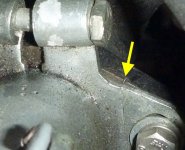Swiss Toni
Member
Offline
Just checking things before replacing the points and condenser and thought I'd check the Dwell.
The manual says 35 degrees +\- 3 deg.
At idle (925, it's a bit high but it likes it there with the cam and Webers) I have 40 deg and when rev it up say to between 1500 and 2300 the dwell drops to 34 to 32 and back to 40 to 41 when it settles back down to idle.
Any thoughts?
The manual says 35 degrees +\- 3 deg.
At idle (925, it's a bit high but it likes it there with the cam and Webers) I have 40 deg and when rev it up say to between 1500 and 2300 the dwell drops to 34 to 32 and back to 40 to 41 when it settles back down to idle.
Any thoughts?

 Hi Guest!
Hi Guest!

 smilie in place of the real @
smilie in place of the real @
 Pretty Please - add it to our Events forum(s) and add to the calendar! >>
Pretty Please - add it to our Events forum(s) and add to the calendar! >> 



